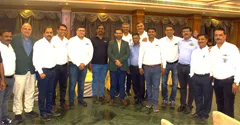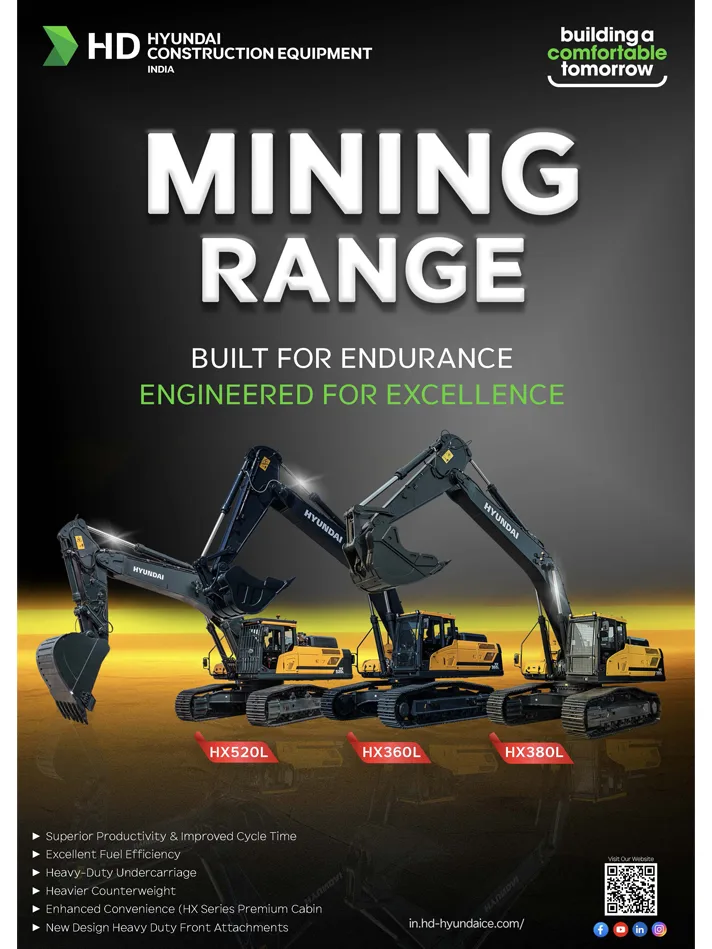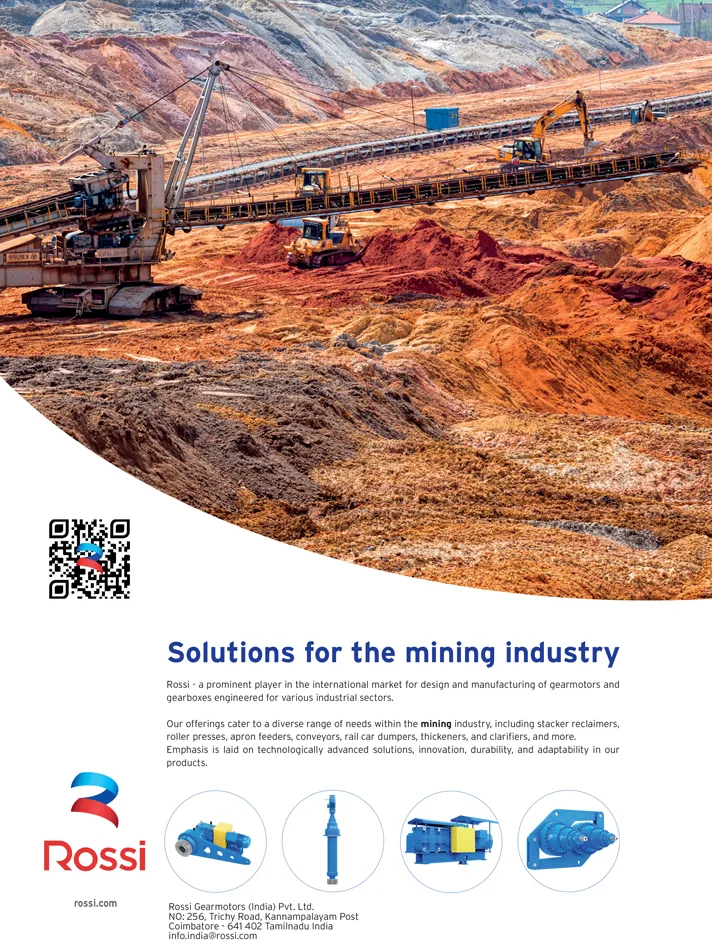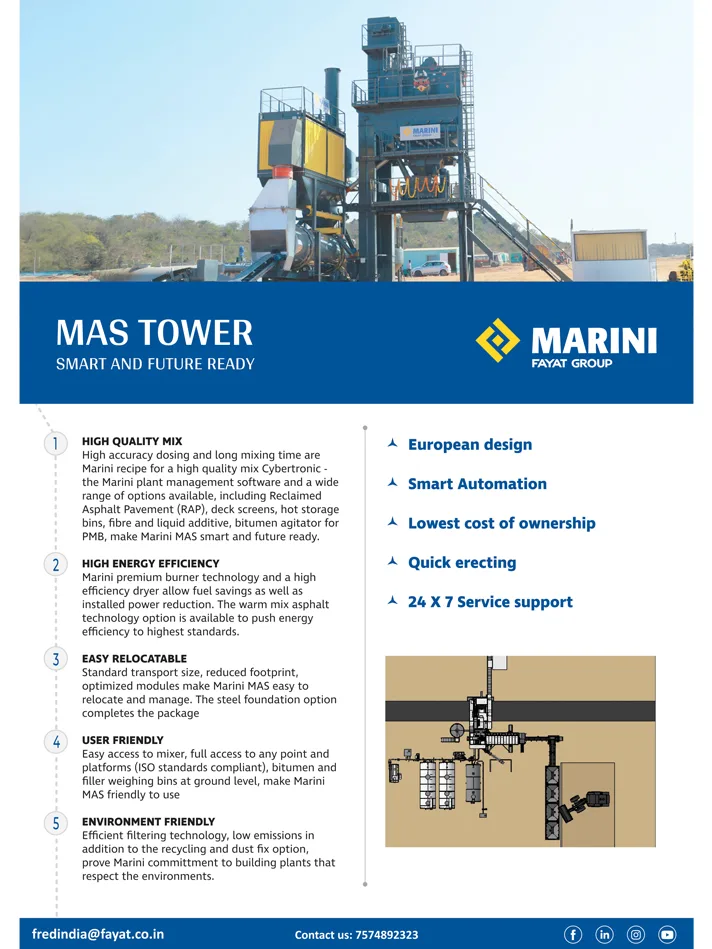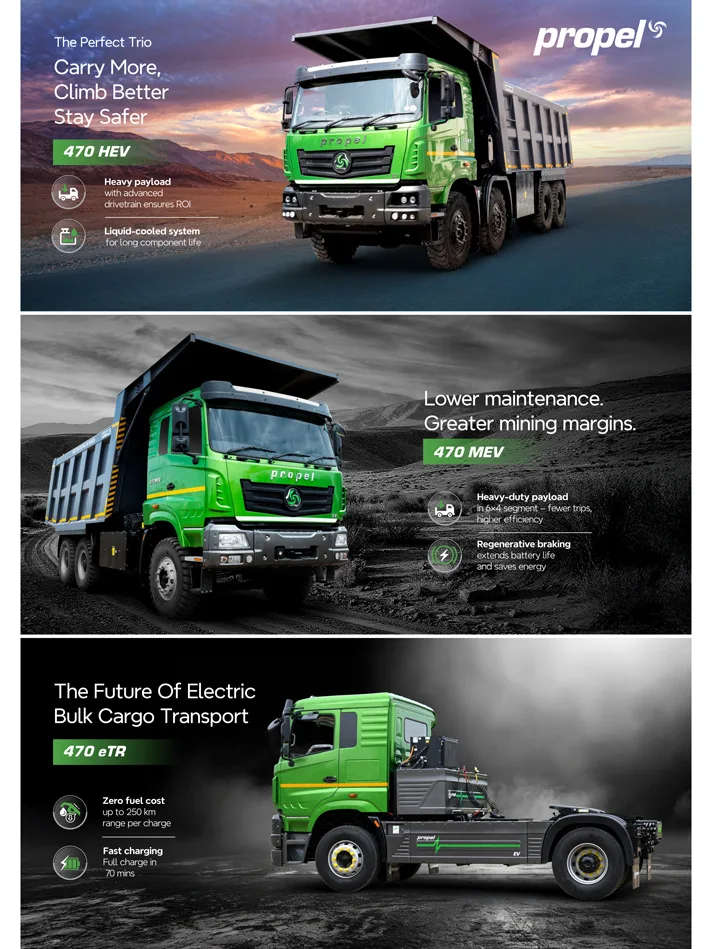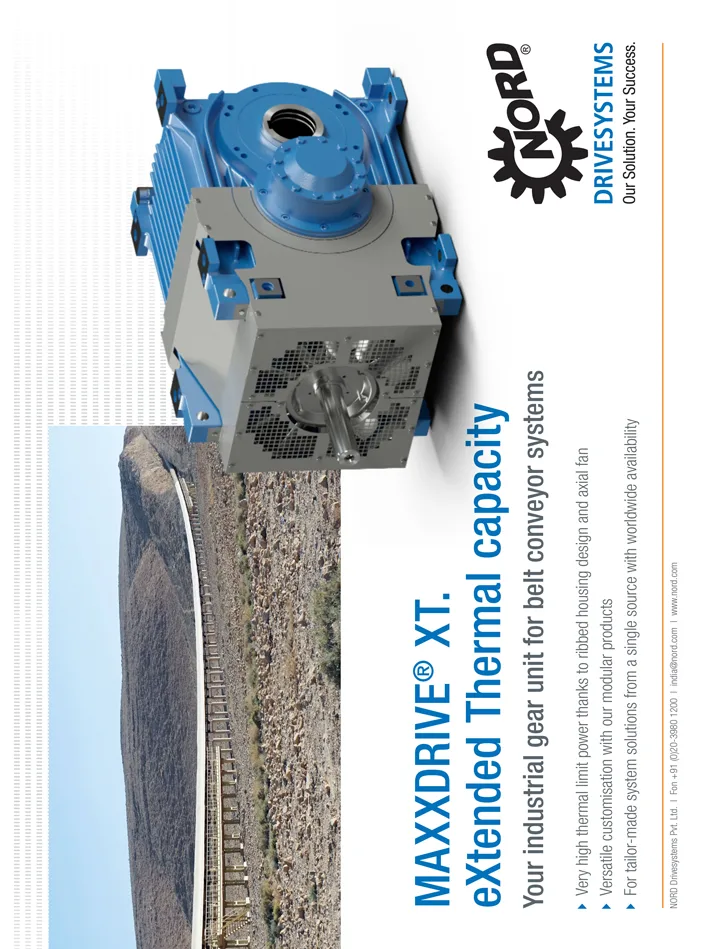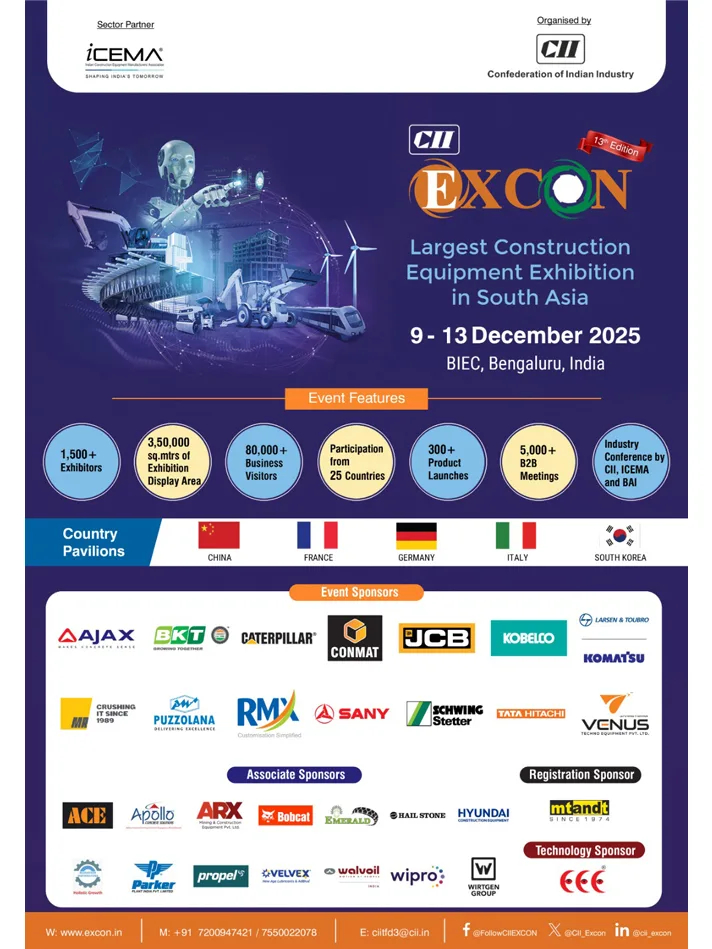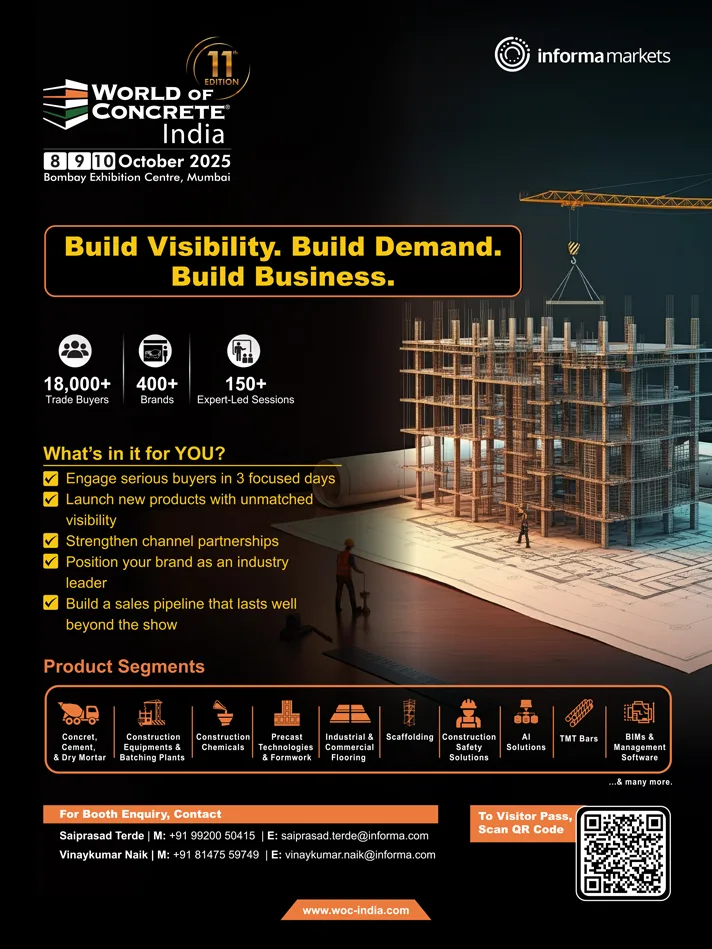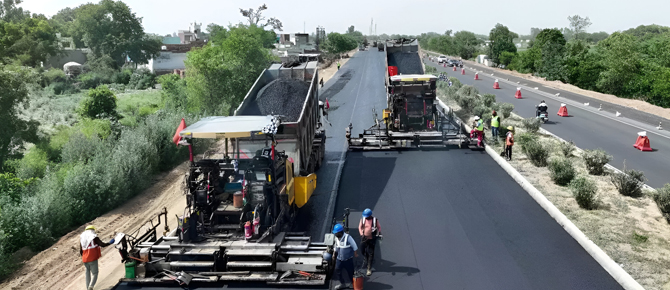
ROAD to PROSPERITY…
India’s vast road network is the backbone of the country’s economic & social affluence and notably so, the Central Government has been taking all the right measures to enhance the connectivity across the length & breadth of the country. The recently announced Interim Budget 2024-25 also highlighted the critical importance of an impeccable infrastructure network. To achieve the Government’s vision of ‘Viksit Bharat by 2047’, the need to strengthen road network is paramount and all the stakeholders are taking concerted efforts to embark on this promising ROAD to Prosperity… writes, PRERNA SHARMA.
India is embarking on a massive infrastructure overhaul. The ambitious plan by the Ministry of Road Transport and Highways aims to transform the nation’s highway network, paving the way for a more prosperous future. In its bid to achieve this ambitious goal, the government has initiated to convert all existing single-lane national highways into double lanes. This infrastructure push aligns perfectly with the government’s vision of “Viksit Bharat by 2047”. The focus on high-speed access-controlled highways signifies India’s aspirations to join the league of nations with world-class road networks.
As the first phase of Bharatmala project is facing huge time and cost overruns, the government is planning to subsume the yet-to-be -awarded projects under the programme in the 2047 Vision Plan of the ministry of road transport and highways (MoRTH). The first phase of Bharatmala Pariyojana was launched in 2017 to build 34,800 km of highways at the cost of Rs.5.35 trillion by 2022. The projected cost has now risen to Rs.10.95 trillion and only 15045 km of highways of 42% of the target have been constructed.
Award figures for the project stands at 27,384 km which is 78% of the total. The sanctioned cost of projects that have been awarded are touching Rs.8.5 trillion. Actual spending under the project has been Rs.4.1 trillion till October-end. The remaining projects under Bharatmala would be made part of the Vision 2047 plan that also aims to build 50,000 km of high speed corridors. Currently the total length of high speed corridors in the country stands at 3,913 km.
“The next phase of highway development will be guided by Vision 2047 which has been finalised by the ministry under which 50,000 km of access controlled highways is proposed to be constructed,” Road Transport and Highways Secretary Anurag Jain said. The Vision plan is awaiting approval of the cabinet. While developing these highways the goal would be to make them accessible at a distance of 100-125 km from any point in the country, Jain said.
The Prime Minister, Narendra Modi inaugurated and laid the foundation stone of 112 National Highway projects spread across the country worth about Rupees One lakh crore.
Emphasizing the change of speed in implementation of projects, the Prime Minister said that in less than three months of 2024, projects worth more than Rs.10 lakh crore have been either dedicated to the nation or foundation stone has been laid for them. Today’s more than 100 project worth more than Rupees One Lakh Crore include development projects from Karnataka, Kerala and Andhra Pradesh in South, from the North, Uttar Pradesh and Haryana related development works are there, East is represented by projects from Bengal and Bihar whereas, from West, major projects from Maharashtra, Punjab and Rajasthan are there. Today’s projects include, said the Prime Minister, an increase of 540 km in Amritsar Bhatinda Jamnagar Corridor and development of Bengaluru Ring Road.
Major projects for which the foundation stone will be laid include 14 packages of Bengaluru – Kadappa – Vijayawada Expressway worth Rs.14,000 crores in Andhra Pradesh; six packages of Belgaum – Hungund – Raichur Section of NH-748A worth Rs.8,000 crores in Karnataka; three packages of Shamli – Ambala Highway worth Rs.4,900 crores in Haryana; two packages of Amritsar – Bathinda corridor worth Rs.3,800 crores in Punjab; along with 39 other projects worth Rs.32,700 crores in different states across the country. These projects will significantly contribute towards the growth of the National Highway network as well as help in boosting socio-economic growth, enhance job opportunities and promote trade & commerce in regions across the country
Progress Made so far…
The Ministry of Road Transport and Highways expects to construct anywhere between 12,000 and 13,000 km of national highways in 2023-24, which will be the second highest national highways construction in the country. The highest annual construction so far has been 13,327 km in 2020-21 while the second `highest was 10,855 km in 2018-19. The ministry has completed construction of 7,685 km till the end of January 2024. It had set a construction target of 13,814 km for FY ’24.
According to Jain, the current financial year will however see highest ever four-lane roads being constructed and highest ever speed or access controlled highways with capacity augmentation pegged at 9,500 km which will be a record for the ministry.
“Upto January 2024, we have seen a 10% year-on-year growth while the increase in construction of four-lane highways is 16%,” he said, adding that the construction of four-lane and above roads now stands at two-and-a-half times the annual achievement of FY ’14.
In yet another important update, the Ministry of Road Transport and Highways (MoRTH) has received a fresh booster, with the Union Budget raising the allocation by 2.8% to around Rs.2.78 lakh crore for 2024-25 from 2.7 lakh crore a year back. Higher budgetary allocations will be necessary to help the ministry develop more highways and expressways in the country, amid rising interest expenses and increasing land acquisition costs. The government allocated Rs.11.1 lakh crore as capital expenditure for the next fiscal year. Out of the total Rs.Rs.2.78 lakh crore, the National Highways Authority of India (NHAI) has been allocated around Rs.1.68 lakh crore as part of MoRTH’s capital expenditure plan for 2024-25, a 3.9% increase from 2023-24, when it was allocated Rs.1.62 lakh crore.
Equipment Companies – Ably Transforming the Pace of Construction
The compaction and paving equipment industry in India is currently experiencing a robust upswing, driven by the nation’s ambitious infrastructure projects and the increasing demand for efficient road construction and maintenance machinery. Recent sales data indicates a substantial year-on-year growth of 18% in the first quarter of FY24. This remarkable growth is attributed to the government’s emphasis on infrastructure spending and the imperative to complete projects promptly ahead of the significant Lok Sabha elections scheduled for 2024. Additionally, the government’s plan to allocate the majority of funds in the current calendar year is expected to further bolster sales in the second and third quarters of FY24. This positive trend underscores the industry’s resilience and its essential role in facilitating India’s rapid urbanization and modernization endeavors.
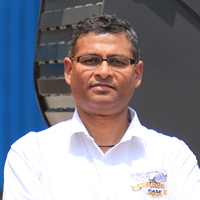
According to Puneet Vidyarthi, Head of Marketing & Business Development – India & SAARC, Case Construction Equipment, “Notably, in India, the government has embarked on transformative initiatives like the Bharatmala Project, aimed at the comprehensive development and enhancement of the national highway network. Compaction sector assumes a pivotal role in shaping infrastructure landscapes, prompting a proliferation of road and highway construction endeavors across various regions. Moreover, India’s National Infrastructure Pipeline (NIP) is poised to expedite the development and modernization of road and highway networks. NIP, steered by the government, identifies transportation as a critical priority and has allocated a staggering $1.4 trillion for infrastructure investments by 2025.”
Vidyarthi adds, “Our Compaction & Paving equipment portfolio is designed to cater to a wide range of compaction and road construction needs. One of our key offerings is the CASE 952EX Soil Compactor, a robust machine built for medium to heavy-duty tasks. Equipped with a state-of-the-art diesel oxidation catalyst (DOC) system, it ensures comprehensive after-treatment and up to 5% higher fuel efficiency. This compactor features an electronically turbocharged engine compliant with BS (CEV) IV (India) regulations, guaranteeing improved responsiveness and overall performance. Safety is a paramount consideration, with features like a secondary braking system, exceptional front and rear visibility, a sliding operating seat, and excellent ground clearance for effortless maneuverability. The advanced console provides a clear and intuitive display with 19 visuals and 10 auditory warnings, including crucial information such as water in fuel, low engine oil pressure, and more. For added practicality, it includes a 12V power socket for mobile charging. Compact and highly portable, the 952EX is an excellent choice for various construction and road compaction applications.”
Additionally, its latest addition, the 1107EX PD Soil Compactor, is tailored for versatile applications and typical compaction tasks. It offers a standard drive and smooth drum along with a pad foot drum and double drive for compressing cohesive materials. This machine incorporates advanced features like ECO mode and One Touch Idle mode, delivering up to 6% improved fuel efficiency. Furthermore, it boasts a low-maintenance design thanks to its state-of-the-art engine technology, aligning perfectly with the evolving needs of the road construction market. We have recently upgraded the edition of Vibratory Compactor (VC), which is the sole one in the sector that incorporates telematics, underscoring our dedication to pioneering advancements.
CASE’s C-series of Motor Graders (845C and 865 C) are powerful machines with the FPT 6.7L turbocharged BS (CEV) IV, electronically controlled diesel engine. The intelligent hydraulic system with a load sensor allows operators to regulate the moldboard from the cabin itself, resulting in increased productivity and operator comfort. The motor generates variable Horsepower at 220 rpm – 193HP /205 HP / 220 HP and is ideal for mining applications.
JCB hydrogen-powered backhoe loader prototype, part of a £100 million investment, was recently unveiled alongside JCB’s unique hydrogen combustion engine. The company states its existing drive to reduce fuel consumption means its diesel-powered machines use 50% less fuel today on an average than those manufactured more than a decade ago. This has saved 16 billion litres of fuel already, which is equivalent to 53 mn tonnes of CO2.

Deepak Shetty, CEO and MD, JCB India, said, “India is making concerted efforts towards making hydrogen our zero-carbon fuel of the future; the National Hydrogen Mission is creating the conditions for a hydrogen ecosystem, which is essential for making a success of this cutting-edge hydrogen combustion technology.”
Shetty further shared his optimism that “It’s only a matter of time before hydrogen becomes readily available in India for a variety of applications. The transition from diesel to hydrogen will be much faster than what we think, and JCB India will be ready. Our hydrogen combustion technology is already well-developed; many machines are currently under test, and JCB is the first construction equipment manufacturer to have unveiled working hydrogen combustion engines, and prototype machines powered by such engines. What you’re seeing here today is Asia’s first construction machine, powered by a hydrogen combustion engine.”
In the dynamic world of road construction, the introduction of the Dynapac CC2200 VI asphalt roller with seismic technology marks a significant leap forward. Superior Paving Corporation, an industry-leading asphalt paving company, has been instrumental in integrating innovative technology into their operations. The Dynapac CC2200 VI recently completed a rigorous set of tests throughout Europe and the United States, including a major highway project for Superior Paving, and is set to redefine the standards of efficiency and precision in road paving compaction.
The CC2200 VI weighs 7.6 tons and features a 59-inch drum, which is ideal for finish rolling on a variety of job sites. It includes a Tier 4 Final diesel engine with a high torque setting, efficient patented eccentric weights, and an ECO Mode for fuel efficiency. The seismic technology is designed to further optimize compaction efficiency, reduce fuel consumption, and enhance operator comfort.

Vishwesh Rai, General Manager, Fayat Road Equipment, Sales India, said “ In current scenario it is demand of time that we need innovations for speedy and quality road construction. Dynapac has inherited culture of continuous improvement & innovation for superior performance & reliability. Our equipment is designed to perform and built to last in terms of low cost of ownership, quality results, high productivity, Jobsite confidence & excellent serviceability. In compactors we have optimized eccentricity for better fuel efficiency & economy. Dynapac was the first to introduce the efficient eccentrics system to the market in 2016. Dynapac equipment are equipped with high degree of intelligent compaction system.”
Volvo CE is taking the lead in making operations in mining, material handling, steel, cement, and urban infrastructure more eco-friendly. They launched EC500 Electric, the first-ever electric excavator in India in the 50-ton category. This big move is a step towards making mining and construction machinery emission-free. DD40 Electric contributes to a cleaner and more enjoyable work environment for operators and site teams. Thanks to its size and energy source, DD40 Electric is perfect for noise- and emission sensitive areas such as landscaping projects or indoor work. An electric machine can help reduce costs by more than 60%, thanks to the cost-effective nature of electricity as a power source, compared to fuel. The DD40 Electric is a 3.8 metric ton compactor that is used on small jobs by itself or assists with large jobs. It is a perfect match for projects that have sensitive or urban regulations. This may include road and parking lot compaction, smaller jobs, urban or sensitive areas like landscaping. The DD40 Electric can operate with up to 30% more power than conventional machines at high altitudes where naturally aspirated diesel engines lose power. DD40 Electric is designed to operate for a full shift on a single charge, depending on the type of job and intensity. Integrated on-board charger allows for overnight charging from 0 to 100% in less than 7 hours, depending on AC power level. Optional off-board DC fast charger enables charging

from 0 to 100% in less than 1 hour. Dimitrov Krishnan, Managing Director, Volvo CE India, said “We stand at the forefront of an Indian earthmoving equipment market projected to reach a phenomenal 10-15% CAGR over the next five years. This surge is driven by the growing demand for clean technologies, perfectly aligning with Volvo CE India’s mission to be a catalyst for positive change. Our excavators, haulers, wheel loaders, and other equipment cater to a diverse range of sectors, including construction, mining, infrastructure development, and material handling. We go beyond offering products; we drive a paradigm shift with innovative electric solutions and comprehensive sustainability support. By making sustainable options accessible and desirable, we aim to leave a lasting legacy of positive change,”
Many contractors who have almost exclusively worked with conventional hot mixes up until now often ask themselves how reduced-temperature asphalt behaves during paving by road pavers. Vögele has been exploring this subject for a long time, researching and testing the paving of various such mixes – and providing real-world solutions.
With Vögele, the benefits gained during the paving process start even before turning on the paver. The mobile feeders in the PowerFeeder series – the MT 3000-3i Standard and the MT 3000-3i Offset – are essential when processing reduced-temperature asphalts. This is because they can unload a complete truck with 25 tons of mix in just 60 seconds. In conjunction with an additional container on the paver, it’s possible to hold up to 45 tons of material – ensuring that paving can continue without interruption. This lays the foundation for the largest possible time window for compaction, which is particularly critical when using low-temperature asphalt. An effective conveyor heating system also contributes to this, keeping the asphalt at the right temperature during transport to the paver. Vögele technology also plays a decisive role in producing unparalleled paving results. The SUPER pavers feature a patented innovation that is particularly noteworthy in this context: the heated auger unit. “The component is located exactly at the point where the material falls onto the distribution auger and is distributed laterally. Heating it effectively prevents the material from sticking,” says Bastian Fleischer, product manager at Vögele, explaining the benefits of the exclusive and low-maintenance solution.
In addition, the components of every Vögele screed that come into contact with the material are also heated electrically. The use of Vögele’s high-compaction technology has proven to be particularly beneficial during paving. In this context, pressure bars powered by pulsed-flow hydraulics achieve a high degree of pre-compaction, which also extends the window of time for the rollers. In addition, Vögele has also developed and is already using specific technologies that greatly improve the processing of reduced-temperature asphalts – namely WITOS Paving Plus and RoadScan.
HAMM recently presented its first fully electric battery-driven tandem rollers. The models form part of the HD CompactLine series and will initially be available for the European market. Some models are fitted with oscillation drums, including the world’s first e-combination rollers featuring oscillation. Not only is compacting with these models emission-free, it’s also ultra-quiet.
With eight electric rollers in the compact class, HAMM’s launch represents a milestone for the compaction industry. The HD 10e model (drum width: 1.00 m, operating weight: 2.5 t) and the HD 12e model (drum width: 1.20 m, operating weight: 2.7 t) boast the same compaction power as their combustion engine counterparts but produce zero emissions. The e-rollers are operated in exactly the same way as the other models in the HD CompactLine series.
One Li-ion battery (capacity 23.4 kWh) provides the energy for the travel, steering, and vibration or oscillation drives via a 48-V system. Staff do not require any specialist training or qualifications to operate the low-voltage system. The battery can be charged via a rapid-charge plug (400 V, CEE) or a standard plug (230 V, earthed adapter). To charge the battery from 0% to 100% takes approx. 4 hours (400 V) or approx. 7.5 h (230 V). The battery is designed to operate in ambient temperatures of up to 45 °C and provides enough energy for one typical work day.
HAMM has fine-tuned every aspect of the e-rollers to preserve resources. For example, the models feature an automatic electric motor stop as standard. This deactivates all functions when the machine is idling, thereby reserving precious battery capacity. When ECO mode is selected, the control limits the working speed. This also saves energy, as does the LED lighting, which is fitted as standard. The innovative steering control also helps to conserve energy: In the parking position, it uses no energy at all. The steering motor does not switch on until the electric driving lever is actuated. Then the machine steers with sensitive responsiveness and an adaptive energy supply with no additional effort.
Compaction technology can have a significant impact on your bottom line. Utilising technology can help you eliminate passes and deliver substantial savings in labor, fuel and machine wear. The technology also can ensure compaction goals have been achieved, eliminating the need for costly re-work at the jobsite.
The patented Ammann triple-shaft exciter system provides industry-leading climbing ability and compaction output. It ultimately delivers outstanding results, even on cohesive soils. The triple-shaft exciter system eliminates erratic movements, allowing smooth travel even through heavy, cohesive soil. The unique system’s consistent movement enables effortless climbing over obstacles or while compacting backfill materials with high moisture content. This is done without the usual suction effect, which can leave plates at a standstill. The ease in handling and manoeuvering of the plate is particularly helpful when the use of low frequency/high amplitude is required.
ACE is a proprietary compaction system from Ammann that provides accurate, real-time data to operators. Precise, transparent and verifiable compaction processes increasingly are required on construction sites. Ammann took the first steps toward providing these processes in 1998 with the advent of Ammann Compaction Expert (ACE), an automated compaction measurement and control system.
Ammann India launched several new products, including a 7m track paver and a 9m track paver (both of which are entirely indigenous), a battery-operated 2-ton tandem roller, and a 5-ton soil compactor, making it the only company in India offering a soil compactor of smaller capacity. Currently, most customers rely on tandem rollers for soil compaction in the less than 9 ton segment for lack availability of smaller soil compactors in the market.
“Our latest asphalt batch mix plant is significant for its environmental control features; it can take RAP

materials up to 60%, setting a new standard in technology. In contrast to our competitors, our technology ensures a perfect mix without the risk of bitumen burnout, resulting in higher road quality. The first plant has already been supplied to GR Infra, a Delhi-based contractor, with over 100,000 tons of asphalt produced and laid,” informed Dheeraj Panda, MD, Ammann India.
“Recycling is gaining popularity, driven by government initiatives for environmental conservation. We have the technology to achieve up to 100% recycling, leveraging our parent company’s extensive experience as a 155-year-old company in asphalt plants. We also offer alternative environmental solutions, such as gas, hydrogen, and coal ash as alternative fuels to reduce pollution,” he added.
The company’s product range includes a 30 cubic meter concrete plant with a unique pan mixer design (deviating from the typical drum type mixer). It also has a self-designed 60 cubic meter concrete plant. “Concrete production is a significant area for us, besides other equipment like battery-operated machinery. However, the adoption of battery-operated equipment in India faces challenges due to the higher cost compared to diesel-operated machinery. We are actively working on cost-benefit analyses to demonstrate the long-term cost and other advantages.”
Ammann India has made substantial investments in enhancing its production capabilities, with in-house fabrication and advanced technologies such as robotics. “India’s market is known for its price sensitivity. Although we have advanced technology, contractors may not adopt it unless the government mandates the use of non-conventional energy sources or alternative fuels. Nitin Gadkari has been vocal about these issues, emphasizing the need for environmentally friendly practices,” said Dheeraj Panda.
In terms of ESG initiatives, Ammann is actively working to reduce carbon footprints globally. Regular meetings are held to monitor progress in India, and it plans to invest in emission reduction initiatives during 2024-25. “Transitioning from BS4 to BS5 emission norms will naturally decrease our carbon footprint, and we are exploring sustainable energy sources such as solar and wind power for our factories to further reduce our environmental impact. There is so much talk about green buildings, but the promotion of the green building concept is hindered by lack of case studies demonstrating their long-term benefits. The cost perception of green buildings as expensive, needs to change also, since many forums argue that green construction can be more economical over time,” said Dheeraj Panda.
“To reduce environmental impact in our asphalt plant, we have implemented advanced filtration systems to control emissions and have explored alternative fuels like ethanol, wood dust, gas, and even hydrogen, keeping in line with European standards, especially in environmentally conscious states like Goa and Kerala.”
Caterpillar AP500 asphalt paver and SE47 Series screeds are designed for urban streets, parking lots, rural roads and many other small to intermediate-type applications. This paver and screed combination provides high throughput capability as-well-as application versatility, easy set-up, and a wide paving range. More performance is delivered with increased feeder system capability, more power, and hopper insert capability. The dual sliding stations, easy-viewing display, and unobstructed visibility to the hopper combine to simplify operation.
Configurable screed designs, optimized weight and width, and all-wheel drive options provide contractors with excellent flexibility. Machine weight of less than 14.5 mt (32,000 lb) paver and screed combination enables easy transport on a variety of trailer types. Length of less than 5.65 m (18’ 6”) and width of 2.6 m (8’ 6”) accommodates machine transport without special permits. The front-loading angle of 17 degrees and high front bumper clearance reduces the need for additional blocking when loading onto various trailer designs. Front, middle, and rear tie-down locations make securing the paver highly efficient for quick travel to the next job site.
ROAD AHEAD!

When asked about the promising future for construction equipment,VG Sakthikumar, CMD, Schwing Stetter India, stated, “Some of the areas that will drive SCHWING Stetter India’s business are: urban development and smart city projects, road and highway construction projects, railway and metro projects, airport and port projects, industrial and commercial projects, renewable energy projects, irrigation and water supply projects, mining and tunneling projects, and disaster management and relief projects. Some of the important projects where SCHWING Stetter India’s products have been used with success are: Delhi Metro Rail Project Phase 3, Mumbai Coastal Road Project, Statue of Unity Project, Chenab Bridge Project, Navi Mumbai International Airport Project, Bharatmala Pariyojana Project, and Char Dham Highway Project.”
SCHWING Stetter India offers a range of sustainable construction equipment that are designed to reduce environmental impact and operational costs. Some of the types of sustainable construction equipment offered by the company are electric concrete shotcrete machine, and reduced emission concrete mixer. These products use alternative sources of energy, such as a battery, and have lower fuel consumption and carbon footprint than conventional equipment. Poonam Upadhyay, Director, CRISIL Ratings, said the

increased pace of road construction, accounting for around 40% of construction equipment demand augurs well for the sector’s growth. “Manufacturers are also seeing healthy demand from the real estate and mining sectors, and from contractors of bridges, airports and metro corridors. In addition, some amount of pre-buying of equipment is also likely towards the last quarter of this fiscal, with the sector migrating to CEV Stage-V2 emission norms from April 1, 2024, which will increase equipment prices,” Upadhyay said.
The sector would see better operating leverage and modest capex to keep credit profiles stable this fiscal, driven by continued government focus on infrastructure build-out, especially roads, metros and railways, including projects under the National Infrastructure Pipeline, CRISIL said.


